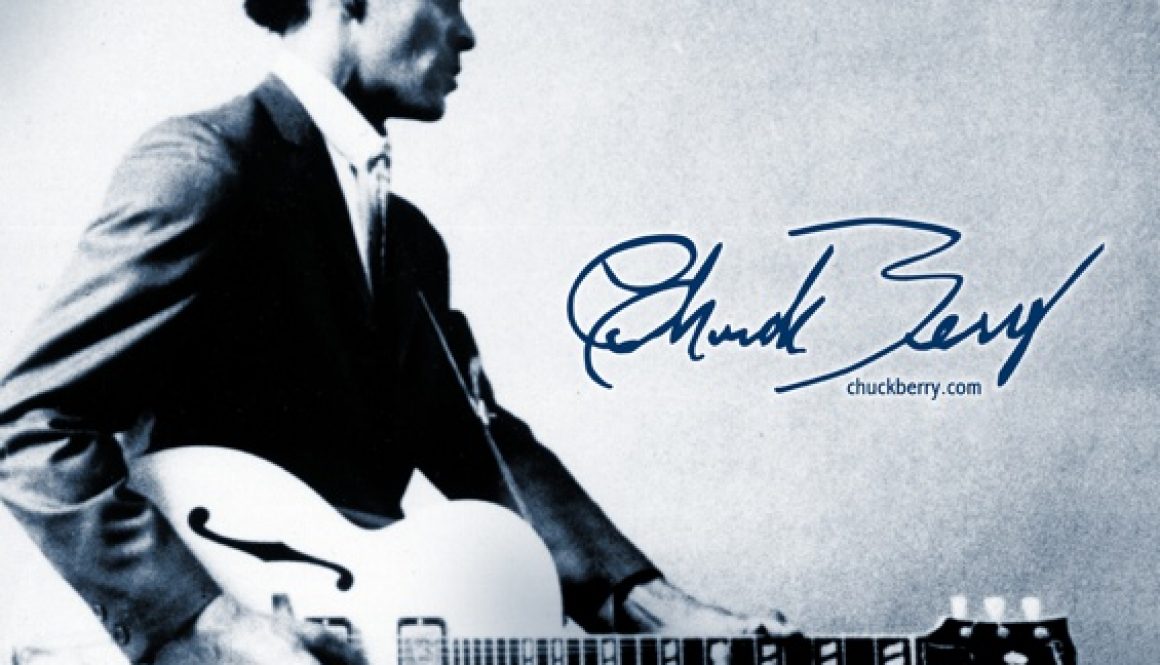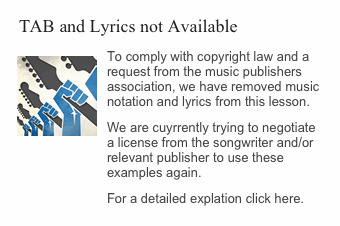Roll Over Beethoven – The Blues – Part 2: Shuffle and Fretboard Positions

All right, then, last time out we learned the standard patterns of twelve bar blues as well as the typical blues shuffle rhythm. Today we’ll take both of these ingredients, toss in a bit of theory and when we’re done you’ll be able to play an amazing number of straight ahead rock and roll songs. All sorts, from Chuck Berry to the Rolling Stones to Led Zeppelin to Bruce Springsteen and more performers than I could possibly list in a simple introductory paragraph. And if we got into all the “slight variations,” our list of songs would soon pirate all of your available memory and then you wouldn’t be able to write to me and complain about it.
So let’s get to it, shall we?
Location, Location, Location
Last time we learned Before You Accuse Me, and in the process we learned how to do a “blues shuffle.” And we learned this in the key of A. Now, most of the books I have ever seen tend to start people out in the key of E, but as I hinted, there is a method to my madness.
We also learned the standard form of “twelve bar blues” songs and how it all revolves around the I, IV and V chords of whatever key in which you chose to play. Are we all set with the form? Good. Now let’s look at the three shuffles used in the key of A.
Now, if you remember, we defined the shuffle as being the root note of the chord in conjunction with the fifth and sixth note of that same chord. And, looking at these three shuffles, we have exactly that. The A chord shuffle is the A note along with the E (fifth) and the F# (sixth). Likewise the D shuffle consists of the D note being played with the A and B notes and the E shuffle being played with the B and the C#. And you might also notice that the root note is always the lower note of the two being played.
Alright then, let’s try to make an intuitive leap. Suppose we had a twelve bar blues song in the key of C. Well, we could probably figure out that the easiest C note to use would be on the third fret of the A string. We might also decide that, even though we could play the G and A (the fifth and sixth of C, right?) on the G string, we’d prefer to stick to the shape we’ve grown to know and love and play our C shuffle (or “I” shuffle) like this:
(And a quick note here: this is going to hurt if you’re not used to stretching your fingers. Use your index finger to anchor the bass note, your ring finger on the fifth and your pinky on the sixth. But if you just keep trying it for a few minutes each time you pick up your guitar you’ll be surprised how quickly you work your way through it.) (This is actually one of those rare times when learning on an electric might be easier – but hang in there!)
Using the same bit of logic, we can figure out our IV and V (F and G chords) shuffles, can we not? Sure, we can:
The lesson I’m trying to get across to you here is this: anytime you start a twelve bar blues shuffle with the bass note of the I chord on the A string (on whichever appropriate fret), the IV will always be immediately above it (on the D string) and the V will be immediately below. Word of honor. Pick a key. How about blues in Eb? Here you go:
This works, of course, because of the way the guitar is tuned. Think about it. Your D note (on the open D string) will always be tuned a fourth higher than the A note and the E note below the A is always going to be the fifth. So as long as you stay on the same frets and keep the “I” of your progression on the A string, this will always hold true.
Now, if you’re still with me, we’ll go and take a quick look at the key of E. Since we already know the chords involved will be E (I), A (IV) and B (V), and since we also know the shuffles for the E and A chords (from our “blues in A” pieces, such as “Before You Accuse Me,” if nothing else), all we have to do is find our B shuffle. Most books, however, will not teach you a B shuffle; they will instead encourage you to use a B7 chord instead. And this is a perfectly acceptable thing to do. Done this way, the last four measures of a twelve bar blues song in E would look like this:
The reasoning behind learning it this is actually very kind hearted. The B major is a relatively difficult chord for beginners while the B7 is definitely do-able, especially if one is swithcing from an E chord.
But since the shuffle does not rely on the full chord, merely two notes, and since we are up to that challenge, let’s again use our brains a little. We already know that going from A to B (from IV to V) is a full step – the equivalent of two frets. So why don’t we simply shift our A chord shuffle up two frets? Piece of cake, right? So here are the shuffles we would use for “blues in E:”
And now, once again, I want you to think about this. If I could teach you any one thing about playing the guitar it would be this: virtually anything you learn concerning a technique or a style or a riff or a chord progression can, with the slightest amount of thought, be applied to another song, style, or whatever. So we look at this and hopefully you see the pattern. If we play twelve bar blues (I, IV, V) where the bass note of I is on the low E (6th) string, then IV will always be directly above it on the A string and to get to V will require us to simply slide IV up two frets. So, instead of playing our A shuffle as we did earlier, it is now possible to play it this way:
And as silly as this is going to sound, you are now ready to rock…
From Blues To Rock
Most early rock and roll songs were derived straight from traditional blues progressions. Many songs today still are. Chuck Berry was one of the best known pioneers in this area and many of his songs went on to inspire the great British rockers of the early sixties. We’re going to learn his classic, Roll Over Beethoven, done in the key of C. I’ve charted this out using (again) the same basic shuffle that we’ve been using the last two sessions (and don’t worry, we’ll soon enough be learning harder ones)(one thing at a time, you know – I already feel like I give you all too much to digest at once!) but I want you to notice the important difference between blues and early rock. Our rhythm has changed! Instead of a laid back shuffle based on a triplet, we have a hard driving shuffle powered by straight eighth notes:
Of course, the first thing that you’ll figure out is that it’s really easy to play this rhythm very fast! But do me a favor, okay? Make certain you keep the timing steady. You speed will come before you’re ready for it, trust me. Okay, are you set? Then let’s go!
And Don’t Forget The “Easy Way…”
If you’ve got smallish hands like me, this style of shuffling if going to take a little bit of time before you get your fingers to stretch the way you want them to. There’s no real way (aside from knowing a good surgeon, I guess) of developing your hands outside of just doing it. But don’t overdo! And remember that you’ve got lots of ways to play in this style without killing your hands. You’ve got your brain. First off, it’s good to realize that the frets are spaced closer together as you get higher up the fretboard. So whenever you can play up there, as we did with this song, then go for it.
But also remember your friend the capo. If you can master the shuffle in A, or the one in E (using the B7 instead of the B shuffle), your capo will enable you to play songs in this style in whatever key you want. Check it out yourself if you don’t believe me. Put your capo on the third fret and play this song with the shuffle fingering (but the straight eighth note rock rhythm) that we used last time out with Before You Accuse Me. And if that’s not enough to get you to open your eyes, now try playing Roll Over Beethoven using the E shuffle chords and fingering we figured out earlier (substituting the B7 for the B) but have your capo on the eighth fret. As I’ve been telling you all along, your brain, working together with a little theory, can help you to overcome a lot when it comes to playing the guitar.
Next time out we’ll go back to the blues once more. As I mentioned, we’ll expand our shuffle a bit and we’ll also have some fun by throwing in some simple “call and response” fills derived from simple blues scales.
As always, please feel free to write in with any questions, comments, concerns or even a song, riff or lead you’d like to see covered in a future “Songs For Beginners” article. You can either drop off a note at the Guitar Forums page or email me directly at [email protected].
Until next week…
Peace
On February 11, 2010 we received a letter from lawyers representing the NMPA and the MPA instructing us to remove guitar tab and lyrics from this page. You can read more about their complaint here. Alternatively, you can still find this complete article with tab and lyrics archived here.









Etienne Pellegrini
September 14th, 2015 @ 8:18 pm
Thank you David for another great lesson! Trying to catch up on you won’t be easy, but it’s a pleasure to learn the guitar with your lessons!
One question about this one though: it sounds like you’re saying that when starting the shuffle with the bass note of (I) on the A string, I should use the (IV) immediately above and the (V) immediately below. But I could also use the (V) that’s 2 frets down the (IV) and play the same scheme as for when the bass is on the E string, no? So basically I could do both those shuffles with the same scheme?
Thanks a lot!
Etienne